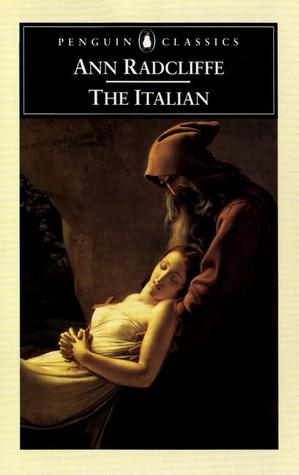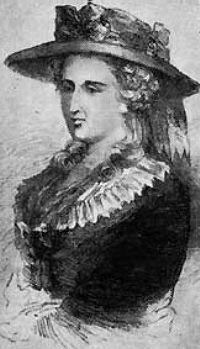
The Italian appeared in 1797 during peak Ann Radcliffe pandemonium. Fueled by the success of her uber bestsellers The Romance of the Forest (1791) and The Mysteries of Udolpho (1794), this new release was destined to be popular, no matter what. Fans were anxious for another Gothic thriller by their favorite author, particularly since the genre had become so fashionable. Matthew Lewis’ The Monk (1796), for example, had recently scandalized readers in all the right ways. When rumor got out that The Italian was Radcliffe’s literary response to Lewis, anticipation whirred like a steam engine.
Certainly the publisher had big expectations. Radcliffe was already the highest paid author in the world after receiving a record-breaking £500 for Udolpho. For the The Italian she was paid £800, or about three times the annual salary of her successful, journalist husband.
As expected, the publication was a hit. Reviews were mostly positive, though many noted it wasn’t as impressive as her prior novels. No review was bad enough to keep fans away, however. Imagine telling Twilight fans that Breaking Dawn wasn’t worth the time. They might believe you, but it wouldn’t stop them from reading it anyway.
Though criticism was not new to Radcliffe, perhaps the negative reactions got to her this time. She did not, at least, publish another novel in her lifetime. As the years went on, much gossip was spread around the bookstalls. It was speculated that she stopped writing after going mad and was locked away in a remote asylum. There were even rumors that she had died from “that species of mental derangement called ‘the horrors.’”
Little biographical information is actually known about Ann Radcliffe, but we do know she neither went insane nor was she locked away like the heroines in her novels. All evidence suggests that, at the ripe age of 32, she simply decided to enjoy a merry life of retirement with her husband and beloved dog. She still wrote here and there, completing the manuscript for an experimental novel called Gaston de Blondeville which was published in 1826, three years after her death. Though I cannot yet comment on Gaston, it doesn’t appear to have resonated with readers at any point in history thus far.
Sadly, even Radcliffe’s four masterworks—A Sicilian Romance, The Romance of the Forest, The Mysteries of Udolpho and The Italian—are not well-known today. Readers generally discover them, as I did, after being enamored by alternative examples of Gothic literature, or from Jane Austen, who alludes to Radcliffe incessantly.
Of these four novels, The Italian is my third favorite overall. It should be noted, however, that its first two hundred pages showcase the cleanest, most enthralling and disciplined prose of her legacy.
As the story unfolds, we’re quickly introduced to a lovesick boy from a prestigious and wealthy family. The object of his affection is a beautiful girl with a golden voice. In fact, it’s her voice which first attracts him, causing him to follow her home and invent lame excuses for conversation.
Though the girl doesn’t seem to reciprocate his passions, he remains determined. He befriends her aunt in hopes of buttering up some persuasion and serenades outside her balcony at night. We then learn that the girl’s hesitancy is not caused by rejection, but the expectation that she, a poor orphan, would never be accepted into a family of grandeur.
As it turns out, she’s right. The boy’s parents refuse to endorse the match and have the girl kidnapped and imprisoned to prevent a hasty marriage. After the boy helps her escape, his mother—along with an evil monk—escalate to plotting the girl’s murder.
Thematic issues of social class are infused throughout, and the lesson ultimately becomes that character is more important than wealth. Kind of. It takes a roundabout way of getting there, and some twists reduce the effectiveness of this moral, but the final scene does sum up the message nicely.
Most of the narrative is set among moonlit dungeons, crumbling architecture, stunning mountainscapes, lush forests, and other picturesque scenery. The villains are equally visual, with wicked countenances all and vile determinations that are unparalleled. The pacing is taut and combustive from the first page, with clear character motivations, an easy-to-digest premise, and no ambiguity over who’s good and who’s bad. At least until the several dozen twists are revealed.
The novel peaks too soon, however, and nearly grinds to a halt around page 200. This is when Radcliffe unveils many bizarre turns of events and must then devote the remaining 200 pages to explaining those surprises and the prior mysteries from earlier chapters.
Though fantastical coincidences are common within the Radcliffe universe, the bombs she drops here reach far into the outlandish, causing more head-scratching than genuine surprise. Furthermore, each outlandish surprise requires an outlandish explanation, so it all gets into the weeds rather abruptly. Explaining away the bizarre is a common complaint of modern Radcliffe readers, though I find the flaws in this book to be an anomaly. Her reveals in other novels tend to be brief, make sense, and are highlights of the narrative.
All that said, she does jazz up these explanatory chapters by giving us courtroom drama involving the Inquisition. It feels a bit like The Merchant of Venice only there’s no clever lawyers arguing the case and there’s minimal mystery regarding truth and lies. Still, she manages to make these pages turn easily, even if what plays out is too strange to be riveting.
So yes, there are slower moments, as there are in her other masterpieces, and unfortunately those slower moments make up the entire climatic part of the story. But they are not so bad as to prevent the novel from being an enthralling tale of romance and horror. Of all her novels, The Italian would probably make the best film. It’s amazing to know this was written long before motion pictures because so much of the atmosphere and action is written in ways that I can only describe as cinematic.
Overall, I suspect the rush to take advantage of her popularity led to a structure that’s more slapdash than usual. Had she managed to find a way to pace out more adventure and less explanation, the book might have been perfect. As it is, it’s still a superb example of Gothic literature that is relentlessly readable and disturbingly relevant, even these 200+ years later.

More Ann Radcliffe reviews…
A Sicilian Romance
The Romance of the Forest
The Mysteries of Udolpho
Join us on social media…
